The Liverpool Telescope, the world’s largest robotic observatory, began operations this week. The 2-metre telescope is operated from Liverpool John Moores University, but it’s actually located in the Canary Islands, and run remotely. The telescope is especially suited to watching astronomical objects which change over time, such as Gamma Ray Bursts, supernovae, asteroids and comets. 5% of its time has been donated to the National Schools’ Observatory program, allowing school children to perform astronomy research.
Palomar Begins a New Sky Survey
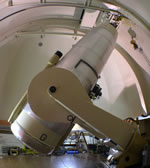
Image credit: Caltech
The Palomar Observatory has begun a new survey of the sky, and will explore the Universe from our solar system out to distant quasars, 10 billion light-years away. The survey will be done with the refurbished 48-inch Oschin telescope with a newly attached digital CCD camera – the largest ever built with 112 separate detectors. The researchers plan to publish images gathered by the telescope onto the web so that other astronomers can search the data for near-earth asteroids, Kuiper Belt objects, supernovae and other objects.
A major new sky survey has begun at the Palomar Observatory. The Palomar-QUEST survey, a collaborative venture between the California Institute of Technology, Yale University, the Jet Propulsion Laboratory, and Indiana University, will explore the universe from our solar system out to the most distant quasars, more than 10 billion light-years away.
The survey will be done using the newly refurbished 48-inch Oschin Telescope, originally used to produce major photographic sky atlases starting in 1950s. At its new technological heart is a very special, fully digital camera. The camera contains 112 digital imaging detectors, known as charge-coupled devices (CCDs). The largest astronomical camera until now has had 30 CCDs. CCDs are often used for digital imaging ranging from common snapshot cameras to sophisticated scientific instruments. Designed and built by scientists at Yale and Indiana Universities, the QUEST (Quasar Equatorial Survey Team) camera was recently installed on the Oschin Telescope. “We are excited by the new data we are starting to obtain from the Palomar Observatory with the new QUEST camera,” says Charles Baltay, Higgins Professor of Physics and Astronomy at Yale University. Baltay’s dream of building a large electronic camera that could capture the entire field of view of a wide-field telescope is now a reality. The survey will generate astronomical data at an unprecedented rate, about one terabyte per month; a terabyte is a million megabytes, an amount of information approximately equivalent to that contained in two million books. In two years, the survey will generate an amount of information about equal to that in the entire Library of Congress.
A major new feature of the Palomar-QUEST survey will be many repeated observations of the same portions of the sky, enabling researchers to find not only objects that move (like asteroids or comets), but also objects that vary in brightness, such as the supernova explosions, variable stars, quasars, or cosmic gamma-ray bursts–and to do this at an unprecedented scale.
“Previous sky surveys provided essentially digital snapshots of the sky”, says S. George Djorgovski, professor of astronomy at Caltech. “Now we are starting to make digital movies of the universe.” Djorgovski and his team, in collaboration with the Yale group, are also planning to use the survey to discover large numbers of very distant quasars–highly luminous objects believed to be powered by massive black holes in the centers of young galaxies–and to use them to probe the early stages of the universe.
Richard Ellis, Steele Professor of Astronomy and director of the Caltech Optical Observatories, will use QUEST in the search for exploding stars, known as supernovae. He and his team, in conjunction with the group from Yale, will use their observations of these exploding stars in an attempt to confirm or deny the recent finding that our universe is accelerating as it expands.
Shri Kulkarni, MacArthur Professor of Astronomy and Planetary Science at Caltech, studies gamma-ray bursts, the most energetic stellar explosions in the cosmos. They are short lived and unpredictable. When a gamma-ray burst is detected its exact location in the sky is uncertain. The automated Oschin Telescope, armed with the QUEST camera’s wide field of view, is poised and ready to pin down the exact location of these explosions, allowing astronomers to catch and study the fading glows of the gamma-ray bursts as they occur.
Closer to home, Caltech associate professor of planetary astronomy Mike Brown is looking for objects at the edge of our solar system, in the icy swarm known as the Kuiper Belt. Brown is convinced that there big objects out there, possibly as big as the planet Mars. He, in collaboration with astronomer David Rabinowitz of Yale, will use QUEST to look for them.
Steve Pravdo, project manager for the Jet Propulsion Laboratory’s Near-Earth Asteroid Tracking (NEAT) Project, will use QUEST to continue the NEAT search which began in 2001. The QUEST camera will extend the search for asteroids that might one day approach or even collide with our planet.
The Palomar-QUEST survey will undoubtedly enable many other kinds of scientific investigations in the years to come. The intent is to make all of the copious amounts of data publicly available in due time on the Web, as a part of the nascent National Virtual Observatory. Roy Williams, member of the professional staff of Caltech’s Center for Advanced Computing Research, is working on the National Virtual Observatory project, which will greatly increase the scientific impact of the data and ease its use for public and educational outreach as well.
The QUEST team members from Indiana University are Jim Musser, Stu Mufson, Kent Honeycutt, Mark Gebhard, and Brice Adams. Yale University’s team includes Charles Baltay, David Rabinowitz, Jeff Snyder, Nick Morgan, Nan Ellman, William Emmet, and Thomas Hurteau. The members from the California Institute of Technology are S. George Djorgovski, Richard Ellis, Ashish Mahabal, and Roy Williams. The Near-Earth Asteroid Tracking team from the Jet Propulsion Laboratory consists of Raymond Bambery, principal investigator, and coinvestigators Michael Hicks, Kenneth Lawrence, Daniel MacDonald, and Steven Pravdo.
Installation of the QUEST camera at the Palomar Observatory was overseen by Robert Brucato, Robert Thicksten, and Hal Petrie.
Original Source: Caltech News Release
South African Observatory Nearing Completion
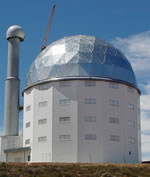
Image credit: SALT
The observatory that will house the largest optical telescope in the Southern hemisphere is nearing completion. The Southern African Large Telescope (SALT) is being built by a consortium of six countries at the southern edge of the Kalahari Desert in Africa. The 11-by-10 metre telescope is 18 months away from being done, but the structure of the observatory is nearly complete. The entire project will cost $18 million and be fully operational in late 2004.
A new observatory that promises to give Wisconsin astronomers unique access to the southern sky is now a prominent feature on a remote South African plateau.
The observatory that will house the largest optical telescope in the Southern Hemisphere, known as the Southern African Large Telescope (SALT), is now nearly complete, according to astronomers at UW-Madison. Although the telescope itself is still 18 months from completion, the mirror segments that will make up the 11-by-10-meter hexagonal primary mirror are starting to come together, says Matthew Bershady a UW-Madison professor of astronomy who is helping to oversee planning and construction of the new observatory.
“We are at a point where we have a structure that is nearly completed,” says Bershady of the observatory situated 220 miles from Cape Town on a mountain plateau at the southern end of the Kalahari Desert. “Now, we are starting to populate the (telescope) truss with glass.”
The $18 million SALT Observatory is being built by a consortium of government and academic institutions from six countries. In addition to UW-Madison, Rutgers and Carnegie Mellon universities, Germany’s University of Gottingen, the University of Canterbury in New Zealand, the United Kingdom Consortium, and the governments of Poland and South Africa are partners in the SALT consortium.
UW-Madison’s contribution is a $3 million imaging spectrograph that is being built under the direction of astronomy Professor Kenneth H. Nordsieck. A spectrograph is a device that breaks light down into its constituent wavelengths, each of which has a different story to tell about the star or galaxy from which the light is gathered.
“We’re past the design stage now,” says Nordsieck of the 500-kilogram instrument that will be at the heart of the new observatory. “We’re cutting metal and polishing glass.”
The Wisconsin spectrograph will be the telescope’s primary scientific instrument. Positioned high above the huge segmented mirror at the prime focus of the telescope, the device will be capable of capturing spectra at a rate of 10 times a second.
To explain the importance of spectroscopy to astronomy, one spectrum – in the words of one astronomer – is worth a thousand pictures.
The device, says Nordsieck, will sample light in the near ultraviolet part of the electromagnetic spectrum: “This is light that our eyes can’t see, but it still gets through the atmosphere. It’s the same kind of light that causes sunburn.”
In addition, the spectrograph will be capable of doing polarimetry, measuring how light waves are scattered as they bounce off objects in space and are pushed and pulled by the immense magnetic fields of interstellar space. Polarimetry, Nordsieck says, helps reveal geometric information, giving astronomers insight into how starlight interacts with the objects it encounters.
“We will also have one of the first large Fabry-Perot devices,” he adds. “It is basically a tunable filter” capable of imaging a large part of the sky.
Fittingly, among the system of lenses to be included in the spectrograph will be a set made of sodium chloride – or salt.
Together, the large, segmented primary mirror and the novel scientific instrumentation will position SALT to break plenty of new ground in the southern skies.
“One of the big things this telescope will be tuned for are the Magellanic Clouds,” says Bershady. “They are important because they are the galaxies nearest to our own, and they offer the best opportunity to study stars and galaxies outside of the Milky Way. It’s always a good thing to look outside of your own immediate environment to find out how unique you are, if at all.”
The SALT construction schedule is right on time, Bershady adds. “That we haven’t slipped at all is amazing,” he says. “Our hope is to stay on track for first light in late 2004.”
Original Source: SALT News Release
New Camera Catches a Near Earth Object Already
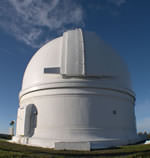
Image credit: NASA
Even though it’s still in its initial commissioning trials, NASA’s Quasar Equatorial Survey (or Quest) camera system attached to the 1.2 metre Oschin telescope on Palomar Mountain has already bagged an asteroid. The 250-metre near-Earth object (NEO) 2003 NL7 was discovered on the evening of July 8 by the Quest system, and then later confirmed by several other observatories. Once Quest is fully operational, it should be 3 to 4 times better than the older equipment it replaced.
NASA astronomers in pursuit of near-Earth asteroids have already made a discovery with the newly installed Quasar Equatorial Survey, or ‘Quest,’ camera mounted in mid-April on Palomar Mountain’s 1.2-meter (48-inch) Oschin telescope.
“The Quest camera is still undergoing commissioning trials,” said Dr. Steven Pravdo, project manager for the Near-Earth Asteroid Tracking Project at NASA’s Jet Propulsion Laboratory in Pasadena, Calif. “But that doesn’t mean we can’t do some real science in the meantime. What we found was a near-Earth asteroid, estimated to be about 250 meters (820 feet) in size.”
The detection of the near-Earth object, 2003 NL7, occurred on the evening of July 8. It has been confirmed by follow-up measurements from three other observatories and subsequently certified by the official clearinghouse of the solar system’s smaller inhabitants, the Minor Planet Center. While 2003 NL7 has been labeled a near-Earth asteroid, it is considered non-hazardous, with a 2.97-year orbit of the Sun in which its closest approach to Earth’s orbit is about 25.1 million kilometers (15.6 million miles).
The Quest camera is being developed as a multi-purpose instrument by Yale and Indiana universities with Dr. Charles Baltay, chairman of Yale’s physics department, as the principal investigator. It is designed for use in detecting and characterizing quasars, near-Earth asteroids, trans-Neptunian objects, supernovas, and a large variety of other astrophysical phenomena, by scientists from Yale, JPL and the California Institute of Technology in Pasadena. The complex camera consists of 112 electronic chips known as charged coupled devices (CCDs) arranged over the Oschin telescope’s focal plane. This gives the Quest camera 161-megapixel capability. By comparison, a good store-bought digital camera would probably be in the four-megapixel range.
“When Quest becomes operational, it will be a significant advancement for the Near-Earth Asteroid Tracking team,” said Dr. Raymond Bambery, the Near-Earth Asteroid Tracking Project’s principal investigator. “We expect the new camera to increase the efficiency of detection of near-Earth asteroids by some 3 to 4 times that of the camera it replaced. This will make a major contribution to NASA’s goal of discovering more than 90 percent of near-Earth objects that are greater that 1 kilometer (.62 mile) in diameter by 2008.”
The Near-Earth Asteroid Tracking System is managed by JPL for NASA’s Office of Space Science, Washington, D.C. JPL is a division of Caltech. More information on the Near-Earth Asteroid Tracking Program is available at http://neat.jpl.nasa.gov/ .
Original Source: NASA/JPL News Release
Destroyed Australian Observatory to Be Rebuilt
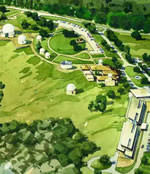
Image credit: ANU
In early 2003 bushfires destroyed much of Australia’s Stromlo Observatory, including five telescopes and several support buildings. On Sunday, July 13, the Australian National University unveiled plans to rebuild the facilities on Mt Stromlo. In addition to building two new telescopes (including a two-metre robotic telescope), the University will also reconstruct several heritage buildings destroyed in the fire.
Bushfires in January destroyed more than $40 million worth of facilities and equipment at the Observatory, including five telescopes, workshops, an important heritage building and seven houses.
Mt Stromlo will resume its mantle as the home of Australian astronomy through the planned redevelopment, which includes the placement of two telescopes on Mount Stromlo and one at the ANU Siding Spring Observatory near Coonabarabran, reconstruction of heritage buildings and enhanced viewing facilities for the public, including a newvirtual reality theatre.
The redevelopment will ensure Mt Stromlo remains a world-class astronomy research and education facility, ANU Vice-Chancellor Professor Ian Chubb said. Funding for the redevelopment, including insurance claims, is yet to be finalised, so the plan allows for staged construction.
?Mt Stromlo is not just an icon of Australian science, it is the workplace of number of the world?s leading researchers,? Professor Chubb said.
?The January fires devastated the observatory, but it is time to look ahead to the new Stromlo.
?It is clear that a site with such heritage, renowned as a powerhouse of research and innovation around the world, must be re-equipped with world-class facilities. The University, the International scientific community and the Australian public would not and could not accept a second-class Stromlo.?
The planned redevelopment includes:
? The Advanced Instruments and Engineering Facility, which will replace the workshops destroyed in the blaze, offering expanded design and manufacture capabilities for precision optical instruments and a research and development program focusing on Extremely Large Telescopes
? A new robotically-controlled two-metre telescope, the Phoenix
? The world?s fastest sky-mapping telescope, the Skymapper, to be built at the ANU Siding Spring Observatory, but controlled from Mt Stromlo through a broadband link
? Restoration of the historic 1924 Admin building, to house a rebuilt library and offices
? Restoration of the historic 23cm Oddie Telescope
? Housing for Staff and Students
? A new virtual reality theatre, allowing visitors to fly through our universe in 3D
The Director of the Research School of Astronomy and Astrophysics, Professor Penny Sackett, said Mt Stromlo had opened the eyes of tens of thousands of Australians to science and served as a vital resource to international astronomy for decades ? and would continue to play this role in future.
?The fires destroyed much of our infrastructure, but left our most important asset intact ? our people,? Professor Sackett said.
?The day after fires, we committed to restoring Stromlo and its network of facilities as a pillar of Australian science.
?Three weeks after the fires, our staff were back at work on the mountain, working in two office buildings which were largely undamaged.
?We can not and we should not reconstruct a carbon copy of the old Stromlo. This new design is overwhelmingly oriented around meeting the needs of staff, students and visitors ? while also ensuring Stromlo retains its status as an internationally important observatory.
?For decades, Stromlo and Siding Spring have been operated as integrated observatories, combining the virtues of a control base close to ANU, close to the nation?s capital and accessible to the community with a primary observation base offering optimal astronomical and climatic conditions.
?The new design retains telescopes and the research hub at Stromlo, but provides even stronger integration with the University?s Siding Spring resources, ultimately providing a more powerful research facility for Australia.?
Original Source: ANU News Release
Gemini Pictures Rival Hubble
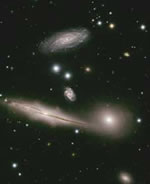
Image credit: Gemini
Thanks to its adaptive optics system and new imaging spectrograph, the Gemini observatory in Chile is producing images that rival those taken by the Hubble Space Telescope. One image of the Hickson Compact Group 87 (HGC87), a group of galaxies located 400 million light years away in the constellation of Capricornus, looks identical to that taken by Hubble. The seven-metre Gemini South is still being tested, but it’s expected to begin scientific operations in August, 2003.
Gemini Observatory’s new imaging spectrograph, without the help of adaptive optics, recently captured images that are among the sharpest ever obtained of astronomical objects from the ground.
Among the images and spectra acquired during recent commissioning of the Gemini Multi-Object Spectrograph (GMOS) on the 8-meter Gemini South Telescope, one image is particularly compelling. This Gemini image reveals remarkable details, previously only seen from space, of the Hickson Compact Group 87 (HCG87). HCG87 is a diverse group of galaxies located about 400 million light years away in the direction of the constellation Capricornus. A striking comparison with the Hubble Space Telescope Heritage image of this object, including resolution data, can be viewed at http://www.gemini.edu/media/images_2003-3.html.
“Historically, the main advantage of large ground-based telescopes, like Gemini, is their ability to collect significantly more light for spectroscopy than is possible with a telescope in space,” said Phil Puxley, Associate Director of the Gemini South Telescope. He explains, “The Hubble Space Telescope is able to do things that are impossible from the ground. However, ground-based telescopes like Gemini, when conditions are right, approach the quality of optical images now only possible from space. One key area – spectroscopy of faint objects, which requires large apertures and fine image quality – is where large telescopes like Gemini provide a powerful, complementary capability to space-based telescopes.”
GMOS-South is currently undergoing commissioning on the 8-meter Gemini South Telescope at Cerro Pach?n, Chile. “GMOS-South worked right out of the box, or rather, right out of the 24 crates that brought the 2-ton instrument to Chile from Canada and the UK – just like its northern counterpart did when it arrived on Hawaii’s Mauna Kea,” says Dr. Bryan Miller, head of the commissioning team. “The GMOS program demonstrates the advantage of building two nearly identical instruments. Experience and software from GMOS-North have helped us commission this instrument more rapidly and smoothly than we could have done otherwise,” explains Dr. Miller. He adds, “Although the images from GMOS-South are spectacular, the instrument is primarily a spectrograph and that is where its capabilities are most significant for scientists.” GMOS-South is expected to begin taking science data in August 2003.
As a multi-object spectrograph, GMOS is capable of obtaining hundreds of spectra in one “snapshot.” The ability to deliver high-resolution images is a secondary function. “It used to take an entire night to obtain one spectrum,” explains Dr. Inger J?rgensen, who led the commissioning of the first GMOS instrument on the Frederick C. Gillett Gemini Telescope (Gemini North) over a year ago. “With GMOS, we can collect 50-100 spectra simultaneously. Combined with Gemini’s 8-meter mirror, we are now able to efficiently study galaxies and galaxy clusters at vast distances – distances so large that the light has traveled for half the age of the Universe or more before reaching Earth. This capability presents unprecedented possibilities for investigating how galaxies formed and evolved in the early Universe.”
GMOS achieves this remarkable sensitivity partly because of its technologically advanced detector, which consists of over 28 million pixels, and partly because of multiple innovative features of the Gemini dome and telescope that reduce local atmospheric distortions around the telescope. “When we designed Gemini, we paid careful attention to controlling heat sources and providing excellent ventilation,” said Larry Stepp, former Gemini Optics Manager. Stepp elaborates, “For example, we constructed 3-story-high vents on the sides of the Gemini enclosures. It is great to see this image that provides such a dramatic validation of our approach.”
“The twin Gemini Telescopes offer a unique advantage,” explains Director of the Gemini Observatory Dr. Matt Mountain. “Now that both telescopes are equipped with nearly identical GMOS instruments, we have created an unprecedented uniform platform to coherently study and take deep spectra of any object in the northern or southern sky at optical wavelengths.”
Upgrades to GMOS-South that will increase its variety of capabilities are planned even as the instrument is undergoing commissioning. An Integral Field Unit (IFU) on GMOS-South is anticipated to begin commissioning in early 2004. Jeremy Allington-Smith, leader of the IFU team at the University of Durham said, “GMOS-South will soon be fitted with an integral field unit like its sister on Gemini North. Made by the University of Durham, it uses more than a thousand optical fibers, tipped at each end with microscopic lenses, to dissect the object under study. This gives GMOS a 3-D view of the target, in which each pixel in the image is replaced by a spectrum. This innovation allows GMOS to make detailed maps of, for example, the motion of stars and gas in galaxies.”
GMOS was built as a joint partnership between Gemini, Canada and the UK. Separately, the U.S. National Optical Astronomy Observatory provided the highly capable detector subsystem and related software (http://www.noao.edu/usgp). It is anticipated that GMOS-South will be available for full scientific operations in August 2003 when astronomers from the seven-country Gemini partnership will begin using the instrument for a wide variety of scientific studies.
The Gemini Observatory is an international collaboration that has built two identical 8-meter telescopes. The Frederick C. Gillett Gemini Telescope is located at Mauna Kea, Hawai`i (Gemini North) and the other telescope at Cerro Pach?n in central Chile (Gemini South), and hence provide full coverage of both hemispheres of the sky. Both telescopes incorporate new technologies that allow large, relatively thin mirrors under active control to collect and focus both optical and infrared radiation from space.
The Gemini Observatory provides the astronomical communities in each partner country with state-of-the-art astronomical facilities that allocate observing time in proportion to each country’s contribution. In addition to financial support, each country also contributes significant scientific and technical resources. The national research agencies that form the Gemini partnership include: the US National Science Foundation (NSF), the UK Particle Physics and Astronomy Research Council (PPARC), the Canadian National Research Council (NRC), the Chilean Comisi?n Nacional de Investigaci?n Cientifica y Tecnol?gica (CONICYT), the Australian Research Council (ARC), the Argentinean Consejo Nacional de Investigaciones Cient?ficas y T?cnicas (CONICET) and the Brazilian Conselho Nacional de Desenvolvimento Cient?fico e Tecnol?gico (CNPq). The Observatory is managed by the Association of Universities for Research in Astronomy, Inc. (AURA) under a cooperative agreement with the NSF. The NSF also serves as the executive agency for the international partnership.
Original Source: Gemini News Release
Gemini Demonstrates Its Adaptive Optics
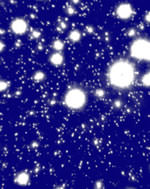
Image credit: Gemini
The latest image taken by the Gemini telescope in Mauna Kea Hawaii demonstrates how powerful its new adaptive optics technology can be. The telescope captured an image of the globular cluster M-13, first with its normal resolution and then using the Altair adaptive optics system; the second image is crystal clear, and contains many more stars which are finely focused. The adaptive optics compensate up to 1000 times a second for distortions caused by the Earth’s atmosphere, so the light appears as if the telescope was in space. This technology is expected to revolutionize ground-based astronomy.
A razor-sharp image was released today revealing new details at the heart of a famous star cluster. The thousands of swarming stars at the cluster’s core were made visible by an innovative adaptive optics system called Altair (after the star Altair) that is currently being commissioned on the Frederick C. Gillett Gemini Telescope on Mauna Kea, Hawai`i.
Among several of the first images from Altair (Altitude Conjugate Adaptive Optics for Infrared), the high-resolution data reveal multitudes of stars with stunning clarity. The dense star cluster known to generations of skywatchers as the Great Hercules Cluster or M-13 is home to hundreds of thousands of stars that, in the center, are often blurred by our atmosphere into a great glowing mass. “The resolution obtained in these images is approximately equivalent to seeing the separation between an automobile’s headlights on the Golden Gate Bridge in San Francisco while standing 3,850 kilometers away in Hawai`i,” said Observatory Adaptive Optics Scientist Dr. Francois Rigaut.
The close-up images of M-13, with and without Altair, as well as a spectacular reference image of the entire cluster, provided by the Canada-France-Hawaii Telescope, can be viewed and downloaded at: http://www.gemini.edu/media/images_2003-2.html.
The remarkable detail in the Gemini images was made possible by Altair’s unique ability to correct starlight that has been blurred by atmospheric turbulence using adaptive optics with altitude conjugation.
Most adaptive optics systems that are currently in use correct for distortions to starlight by assuming that all of the distortions occur where starlight is collected – near the surface of the telescope’s primary mirror. In an altitude-conjugated system like Gemini’s, the distortions are assumed to be at the dominant turbulence layer of the atmosphere. By conjugating or tuning the system for a specific layer above the telescope, Altair can generate a more accurate model of the starlight’s path through our atmosphere.
“Adaptive optics with altitude conjugation is a pioneering new technique that is a powerful way to measure and fix distortions to starlight, which traveled undisturbed for vast distances through space until hitting pockets of warm and cold air in earth’s atmosphere,” said Glen Herriot, the systems engineer who managed the building of Altair in Victoria, BC at the laboratories of the National Research Council of Canada. Altair is able to precisely correct the distorted starlight up to 1,000 times per second using a sophisticated, deformable mirror about the size of the palm of your hand. “The end result is,” says Herriot, “images that rival or even exceed the sharpness of pictures taken from space.”
Working with Gemini Observatory personnel, the Canadian team headed by Project Manager Herriot and Project Scientist Dr. Jean-Pierre V?ran, have been commissioning Altair on Gemini North from late 2002 through early 2003. The instrument team, comprised of 25 scientists and engineers, guided the Gemini adaptive optics system from design to commissioning over the past six years. “Commissioning a precision instrument on a 7-story, 350-ton, sophisticated telescope is especially challenging because of the extremely intricate coordination required to make all the systems work together seamlessly,” said Herriot. Altair’s commissioning on Gemini is expected to be complete before the end of 2003.
A key feature of Altair’s sophistication is the ability to automatically monitor, adjust and optimize multiple parameters during image exposures. The idea is to make adaptive optics user-friendly for our community. When atmospheric conditions allow, simply point and click and near diffraction-limited images are delivered to a camera or spectrograph. Altair continually measures and reports on the images’ level of detail making it one of the most efficient adaptive optics systems in the world. “By routinely delivering infrared images much sharper than is currently possible even from space, Altair gives observers a tremendous advantage in probing deeper in the universe and making more accurate measurements of astronomical objects,” Dr. V?ran says.
“Altair enormously enhances the quality and power of our imaging and spectroscopy,” says Dr. Matt Mountain, Gemini’s Director. “Gemini will soon deliver diffraction-limited images in the near-infrared.” Gemini’s theoretical diffraction limit (maximum resolution) is about 40 milli-arcseconds in the near-infrared H-band (1.6 micrometers wavelength). At this point in commissioning, Altair can deliver 60-milli-arcsecond resolution in the H-band (60 milli-arcseconds is comparable to viewing one grain of sand from about 1.6 kilometers or 1 mile away).
Dr. Mountain pointed out that Altair’s commissioning means that one of the most sophisticated adaptive optics system in the world is now built-in to Gemini North as a facility instrument, and will soon be routinely available to all scientists throughout the Gemini partnership.
“This is a major achievement towards our Gemini goal of delivering space-quality images from an 8-meter, ground-based telescope,” said Dr. Mountain.
Gemini’s Associate Director Dr. Jean-Ren? Roy explains that Altair is a major step forward in Gemini’s aggressive plans to maximize the potential of adaptive optics on ground-based astronomical imaging. Dr. Roy elaborates, “Altair, representing the foundation of tomorrow’s adaptive optics technology, is important for the success of the next generation of 30- to 100-meter, diffraction-limited, infrared, ground-based telescopes now on the drawing boards.”
Future generations of adaptive optics technologies like these will undoubtedly revolutionize ground-based astronomy. For now, Altair is state of the art and provides a powerful new eye on the universe.
Original Source: Gemini News Release
Paranal Observatory Tests New Adapative Optics
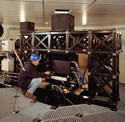
Image credit: ESO
A team of engineers from the European Southern Observatory recently tested out a new adaptive optics facility on the Very Large Telescope (VLT) at the Paranal Observatory in Chile. This technology adapts images taken by the telescope to remove the distortion caused by the Earth?s atmosphere ? as if they were seen from space. The next step will be to connect similar systems to all the telescopes at the facility and then hook them up in a large array. This should allow the observatory to resolve objects 100 times fainter than today.
On April 18, 2003, a team of engineers from ESO celebrated the successful accomplishment of “First Light” for the MACAO-VLTI Adaptive Optics facility on the Very Large Telescope (VLT) at the Paranal Observatory (Chile). This is the second Adaptive Optics (AO) system put into operation at this observatory, following the NACO facility (ESO PR 25/01).
The achievable image sharpness of a ground-based telescope is normally limited by the effect of atmospheric turbulence. However, with Adaptive Optics (AO) techniques, this major drawback can be overcome so that the telescope produces images that are as sharp as theoretically possible, i.e., as if they were taken from space.
The acronym “MACAO” stands for “Multi Application Curvature Adaptive Optics” which refers to the particular way optical corrections are made which “eliminate” the blurring effect of atmospheric turbulence.
The MACAO-VLTI facility was developed at ESO. It is a highly complex system of which four, one for each 8.2-m VLT Unit Telescope, will be installed below the telescopes (in the Coud? rooms). These systems correct the distortions of the light beams from the large telescopes (induced by the atmospheric turbulence) before they are directed towards the common focus at the VLT Interferometer (VLTI).
The installation of the four MACAO-VLTI units of which the first one is now in place, will amount to nothing less than a revolution in VLT interferometry. An enormous gain in efficiency will result, because of the associated 100-fold gain in sensitivity of the VLTI.
Put in simple words, with MACAO-VLTI it will become possible to observe celestial objects 100 times fainter than now. Soon the astronomers will be thus able to obtain interference fringes with the VLTI (ESO PR 23/01) of a large number of objects hitherto out of reach with this powerful observing technique, e.g. external galaxies. The ensuing high-resolution images and spectra will open entirely new perspectives in extragalactic research and also in the studies of many faint objects in our own galaxy, the Milky Way.
During the present period, the first of the four MACAO-VLTI facilties was installed, integrated and tested by means of a series of observations. For these tests, an infrared camera was specially developed which allowed a detailed evaluation of the performance. It also provided some first, spectacular views of various celestial objects, some of which are shown here.
MACAO – the Multi Application Curvature Adaptive Optics facility
Adaptive Optics (AO) systems work by means of a computer-controlled deformable mirror (DM) that counteracts the image distortion induced by atmospheric turbulence. It is based on real-time optical corrections computed from image data obtained by a “wavefront sensor” (a special camera) at very high speed, many hundreds of times each second.
The ESO Multi Application Curvature Adaptive Optics (MACAO) system uses a 60-element bimorph deformable mirror (DM) and a 60-element curvature wavefront sensor, with a “heartbeat” of 350 Hz (times per second). With this high spatial and temporal correcting power, MACAO is able to nearly restore the theoretically possible (“diffraction-limited”) image quality of an 8.2-m VLT Unit Telescope in the near-infrared region of the spectrum, at a wavelength of about 2 ?m. The resulting image resolution (sharpness) of the order of 60 milli-arcsec is an improvement by more than a factor of 10 as compared to standard seeing-limited observations. Without the benefit of the AO technique, such image sharpness could only be obtained if the telescope were placed above the Earth’s atmosphere.
The technical development of MACAO-VLTI in its present form was begun in 1999 and with project reviews at 6 months’ intervals, the project quickly reached cruising speed. The effective design is the result of a very fruitful collaboration between the AO department at ESO and European industry which contributed with the diligent fabrication of numerous high-tech components, including the bimorph DM with 60 actuators, a fast-reaction tip-tilt mount and many others. The assembly, tests and performance-tuning of this complex real-time system was assumed by ESO-Garching staff.
Installation at Paranal
The first crates of the 60+ cubic-meter shipment with MACAO components arrived at the Paranal Observatory on March 12, 2003. Shortly thereafter, ESO engineers and technicians began the painstaking assembly of this complex instrument, below the VLT 8.2-m KUEYEN telescope (formerly UT2).
They followed a carefully planned scheme, involving installation of the electronics, water cooling systems, mechanical and optical components. At the end, they performed the demanding optical alignment, delivering a fully assembled instrument one week before the planned first test observations. This extra week provided a very welcome and useful opportunity to perform a multitude of tests and calibrations in preparation of the actual observations.
AO to the service of Interferometry
The VLT Interferometer (VLTI) combines starlight captured by two or more 8.2- VLT Unit Telescopes (later also from four moveable1.8-m Auxiliary Telescopes) and allows to vastly increase the image resolution. The light beams from the telescopes are brought together “in phase” (coherently). Starting out at the primary mirrors, they undergo numerous reflections along their different paths over total distances of several hundred meters before they reach the interferometric Laboratory where they are combined to within a fraction of a wavelength, i.e., within nanometers!
The gain by the interferometric technique is enormous – combining the light beams from two telescopes separated by 100 metres allows observation of details which could otherwise only be resolved by a single telescope with a diameter of 100 metres. Sophisticated data reduction is necessary to interpret interferometric measurements and to deduce important physical parameters of the observed objects like the diameters of stars, etc., cf. ESO PR 22/02.
The VLTI measures the degree of coherence of the combined beams as expressed by the contrast of the observed interferometric fringe pattern. The higher the degree of coherence between the individual beams, the stronger is the measured signal. By removing wavefront aberrations introduced by atmospheric turbulence, the MACAO-VLTI systems enormously increase the efficiency of combining the individual telescope beams.
In the interferometric measurement process, the starlight must be injected into optical fibers which are extremely small in order to accomplish their function; only 6 ?m (0.006 mm) in diameter. Without the “refocussing” action of MACAO, only a tiny fraction of the starlight captured by the telescopes can be injected into the fibers and the VLTI would not be working at the peak of efficiency for which it has been designed.
MACAO-VLTI will now allow a gain of a factor 100 in the injected light flux – this will be tested in detail when two VLT Unit Telescopes, both equipped with MACAO-VLTI’s, work together. However, the very good performance actually achieved with the first system makes the engineers very confident that a gain of this order will indeed be reached. This ultimate test will be performed as soon as the second MACAO-VLTI system has been installed later this year.
MACAO-VLTI First Light
After one month of installation work and following tests by means of an artificial light source installed in the Nasmyth focus of KUEYEN, MACAO-VLTI had “First Light” on April 18 when it received “real” light from several astronomical obejcts.
During the preceding performance tests to measure the image improvement (sharpness, light energy concentration) in near-infrared spectral bands at 1.2, 1.6 and 2.2 ?m, MACAO-VLTI was checked by means of a custom-made Infrared Test Camera developed for this purpose by ESO. This intermediate test was required to ensure the proper functioning of MACAO before it is used to feed a corrected beam of light into the VLTI.
After only a few nights of testing and optimizing of the various functions and operational parameters, MACAO-VLTI was ready to be used for astronomical observations. The images below were taken under average seeing conditions and illustrate the improvement of the image quality when using MACAO-VLTI.
MACAO-VLTI – First Images
Here are some of the first images obtained with the test camera at the first MACAO-VLTI system, now installed at the 8.2-m VLT KUEYEN telescope.
PR Photos 12b-c/03 show the first image in the infrared K-band (wavelength 2.2 ?m) of a star (visual magnitude 10) obtained without and with image corrections by means of adaptive optics.
PR Photo 12d/03 displays one of the best images obtained with MACAO-VLTI during the early tests. It shows a Strehl ratio (measure of light concentration) that fulfills the specifications according to which MACAO-VLTI was built. This enormous improvement when using AO techniques is clearly demonstrated in PR Photo 12e/03, with the uncorrected image profile (left) hardly visible when compared to the corrected profile (right).
PR Photo 11f/03 demonstrates the correction capabilities of MACAO-VLTI when using a faint guide star. Tests using different spectral types showed that the limiting visual magnitude varies between 16 for early-type B-stars and about 18 for late-type M-stars.
Astronomical Objects seen at the Diffraction Limit
The following examples of MACAO-VLTI observations of two well-known astronomical objects were obtained in order to provisionally evaluate the research opportunities now opening with MACAO-VLTI. They may well be compared with space-based images.
The Galactic Center
The center of our own galaxy is located in the Sagittarius constellation at a distance of approximately 30,000 light-years. PR Photo 12h/03 shows a short-exposure infrared view of this region, obtained by MACAO-VLTI during the early test phase.
Recent AO observations using the NACO facility at the VLT provide compelling evidence that a supermassive black hole with 2.6 million solar masses is located at the very center, cf. ESO PR 17/02. This result, based on astrometric observations of a star orbiting the black hole and approaching it to within a distance of only 17 light-hours, would not have been possible without images of diffraction limited resolution.
Eta Carinae
Eta Carinae is one of the heaviest stars known, with a mass that probably exceeds 100 solar masses. It is about 4 million times brighter than the Sun, making it one of the most luminous stars known.
Such a massive star has a comparatively short lifetime of about 1 million years only and – measured in the cosmic timescale- Eta Carinae must have formed quite recently. This star is highly unstable and prone to violent outbursts. They are caused by the very high radiation pressure at the star’s upper layers, which blows significant portions of the matter at the “surface” into space during violent eruptions that may last several years. The last of these outbursts occurred between 1835 and 1855 and peaked in 1843. Despite its comparaticely large distance – some 7,500 to 10,000 light-years – Eta Carinae briefly became the second brightest star in the sky at that time (with an apparent magnitude -1), only surpassed by Sirius.
Frosty Leo
Frosty Leo is a magnitude 11 (post-AGB) star surrounded by an envelope of gas, dust, and large amounts of ice (hence the name). The associated nebula is of “butterfly” shape (bipolar morphology) and it is one of the best known examples of the brief transitional phase between two late evolutionary stages, asymptotic giant branch (AGB) and the subsequent planetary nebulae (PNe).
For a three-solar-mass object like this one, this phase is believed to last only a few thousand years, the wink of an eye in the life of the star. Hence, objects like this one are very rare and Frosty Leo is one of the nearest and brightest among them.
Original Source: ESO News Release
Six Telescopes Acting as One
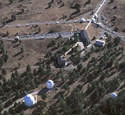
Image credit: USNO
Astronomers from several US observatories announced that they have successfully merged the light from six independent telescopes to form a single, high-resolution image of a distant multi-star system. To create an image with this level of detail, a single telescope would need to be 50-metres across – bigger than anything that currently exists. This technique, called interferometry, has been done with pairs of telescopes before, but never with as many as six.
Astronomers from the U.S. Naval Observatory (USNO), the Naval Research Laboratory (NRL), and Lowell Observatory announced today that they have successfully combined the light from six independent telescopes to form a single, high-resolution image of a distant multiple-star system. This is the first time that this has ever been accomplished in the optical region of the electromagnetic spectrum. The Navy Prototype Optical Interferometer (NPOI) at Lowell Observatory’s Anderson Mesa site near Flagstaff, Arizona observed the triple star system Eta Virginis, located about 130 light-years away from Earth.
“This development makes it possible to ‘synthesize’ telescopes with apertures in excess of hundreds of meters,” says Dr. Kenneth Johnston, Scientific Director of the Naval Observatory. “It will lead to the direct imaging of the surfaces of stars and of star spots, analogous to the sunspots on the Sun. This technology can also be applied to space systems for remote sensing of the Earth and other objects in the solar system, as well as stars and galaxies.”
Optical interferometers combine the light from several independent telescopes to form a “synthetic” telescope whose ability to make a high-resolution image is proportional to the maximum separation of the telescopes. They are the answer to the prohibitive costs and immense technical difficulties of building extremely large, monolithic single-mirror telescopes. Since the rate at which a giant telescope aperture is synthesized with an interferometer array is equal to the number of combinations between any two telescopes of the array, the combination of the six NPOI telescopes has more than quadrupled NPOI’s capability to collect data over its competitors.
USNO and NRL, in collaboration with Lowell Observatory and with funding from the Office of Naval Research and the Oceanographer of the Navy, joined forces in 1991 to build the instrument. Stellar observations have been conducted with a three-station array since its “first light” in 1996.
However, due to the technical difficulty associated with linking even a small number of separate telescopes, the high-resolution capabilities of optical interferometers have only been used to date on relatively simple stellar sources. Basic questions, such as a star’s apparent diameter or the existence and motions of nearby stellar companions, are easily answered for such sources. However, to increase the spatial resolution and sensitivity to stellar structure, interferometers must link more telescopes together to provide an even sampling of the synthesized aperture. Three combined telescopes provide three mea-surements in the synthesized aperture, but six telescopes provide 15 combinations.
To merge the six beams, the NPOI team has designed a new type of hybrid beam combiner. In addition, new hardware and control systems have been developed to uniquely encode every possible telescope combination in the recorded data so that the information necessary for the alignment and superposition of the starlight wave-fronts and the image reconstruction may be properly decoded.
The field of interferometry is a rapidly developing one, with giants like the twin Keck 10-meter telescopes having achieved “first fringes” last year, and the European Southern Observatory’s VLTI planning to combine the light from four 8-meter telescopes. More modest but versatile imaging interferometers like CHARA, COAST, and IOTA have also been operating for a few years, but NPOI is the first to combine light from a full array of six telescopes.
In the near future, NPOI will be commissioning all of the remaining stations onto which any of the six telescopes can be mounted for a maximum array size of 430 meters, the largest baseline of all current imaging interferometer projects.
Stellar astrophysics will be revolutionized by the capability to directly image stars other than the Sun. Ultimately, when employed in space with the experience collected from ground-based experiments, optical interferometry may develop the capability to image Jupiter-sized planets orbiting distant stars.
“Remember the early days of radio interferometry and look at the world- wide arrays we routinely use today,” says Dr. Johnston. “We’ve gone from simple two-element arrays to continent-sized ones with 10 or more antennas that produce extremely fine-scale images of distant quasars. We are standing on the brink of achieving similar results for visible-light sources.”
Original Source: US Naval Observatory News Release
